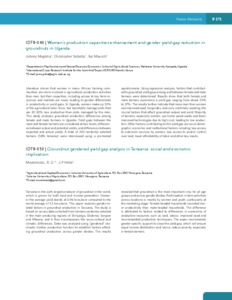Women’s production capacities enhancement and gender yield gap reduction in groundnuts in Uganda
Abstract
Literature shows that women in many African farming communities are more involved in agricultural production activities than men, but their capacities, including access to key farm resources and markets are lower, leading to gender differentials in productivity or yield gaps. In Uganda, women make up 53% of the agricultural labor force, but reportedly manage plots that are 20-30% less productive than plots managed by the men. This study analyses groundnut production differences among female and male farmers in Uganda. Yield gaps between the male and female farmers are considered at two levels; differences between actual and potential yields, and differences between expected and actual yields. A total of 240 randomly selected farmers (58% females) were interviewed using a pre-tested questionnaire. Using regression analysis, factors that contributed to groundnut yield gaps among and between female and male farmers were determined. Results show that both female and male farmers experience a yield gap ranging from about 20% to 37%. The results further indicate that more men than women use improved seed, fungicides, and carry out timely weeding; the crucial factors that affect groundnut output and yield. Majority of farmers, especially women, use home saved seeds and fewer improved technologies due to high cost, leading to low production. Other factors contributing to the yield gap are socio-demographic, economic and institutional factors including less access to extension services by women, less access to and/or control over land, lower affordability of labor and other key inputs

